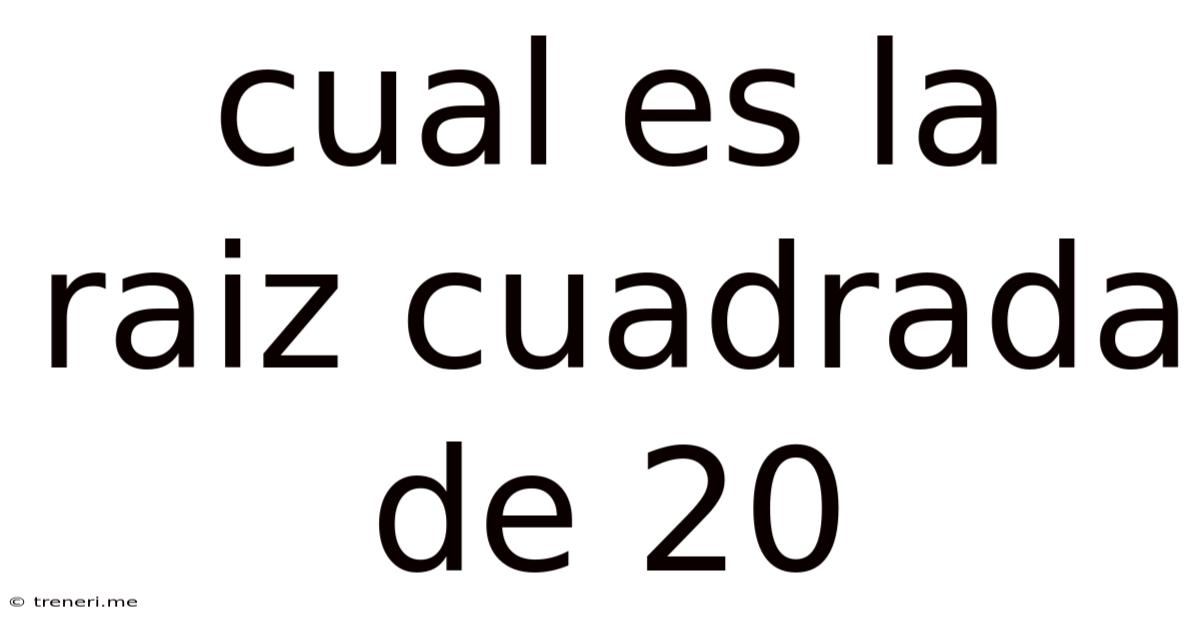Cual Es La Raiz Cuadrada De 20
Treneri
May 15, 2025 · 5 min read

Table of Contents
What is the Square Root of 20? A Deep Dive into Square Roots and Approximations
The question, "What is the square root of 20?" seems simple enough. However, delving into its answer opens up a fascinating exploration of mathematical concepts, approximation techniques, and the beauty of irrational numbers. This comprehensive guide will not only provide the answer but will also equip you with a deeper understanding of square roots and their significance.
Understanding Square Roots
Before we tackle the square root of 20, let's solidify our understanding of what a square root actually is. A square root of a number is a value that, when multiplied by itself (squared), gives the original number. For example, the square root of 9 is 3 because 3 x 3 = 9. We represent the square root using the radical symbol (√).
Key Concepts:
-
Perfect Squares: These are numbers that result from squaring an integer (whole number). Examples: 1 (1x1), 4 (2x2), 9 (3x3), 16 (4x4), 25 (5x5), and so on.
-
Irrational Numbers: These are numbers that cannot be expressed as a simple fraction (a ratio of two integers). Their decimal representation goes on forever without repeating. Many square roots of non-perfect squares fall into this category.
-
Approximations: Since many square roots are irrational, we often use approximations to represent them in practical applications. These approximations can be expressed as decimals (e.g., 4.47) or fractions.
Calculating the Square Root of 20
20 is not a perfect square. There's no whole number that, when multiplied by itself, equals 20. Therefore, the square root of 20 is an irrational number. This means we can't express it as a finite decimal or a simple fraction. We can, however, find an approximate value.
Methods for Approximation:
-
Using a Calculator: The simplest way is to use a calculator. Most calculators have a square root function (√). Inputting √20 will give you an approximation, typically around 4.472135955.
-
Estimation: We can estimate the square root of 20 by considering perfect squares close to 20. We know that 4² = 16 and 5² = 25. Since 20 is between 16 and 25, the square root of 20 must be between 4 and 5. This gives us a rough estimate.
-
Babylonian Method (or Heron's Method): This is an iterative method that refines an initial guess to get a closer approximation. The formula is:
x_(n+1) = 0.5 * (x_n + (20/x_n))where:
x_nis the current approximation.x_(n+1)is the next, improved approximation.
Let's start with an initial guess of 4.5:
x_1 = 4.5x_2 = 0.5 * (4.5 + (20/4.5)) ≈ 4.4722x_3 = 0.5 * (4.4722 + (20/4.4722)) ≈ 4.4721
As you can see, with each iteration, the approximation gets closer to the actual value.
-
Long Division Method: This is a more complex method, but it's a valuable exercise in understanding the mechanics of square root calculation without relying on technology. It involves a step-by-step process of grouping digits, subtracting squares, and bringing down the next pair of digits. This method is beyond the scope of a concise explanation here, but resources are readily available online.
Significance and Applications of Square Roots
Square roots are not just abstract mathematical concepts; they have numerous practical applications across various fields:
1. Geometry and Trigonometry:
-
Calculating distances: The Pythagorean theorem (a² + b² = c²) relies heavily on square roots to determine the length of the hypotenuse (c) in a right-angled triangle. This is crucial in surveying, construction, navigation, and many other fields.
-
Finding areas and volumes: Formulas for calculating areas of circles (πr²) and volumes of spheres (4/3πr³) involve square roots (or their inverses, squares).
2. Physics and Engineering:
-
Velocity and acceleration: Calculations related to motion frequently involve square roots, particularly when dealing with equations of motion.
-
Electrical engineering: The impedance of circuits is sometimes expressed in terms of square roots.
-
Mechanical engineering: Stress and strain calculations often involve square roots.
3. Statistics and Data Analysis:
-
Standard deviation: This critical measure of data dispersion is calculated using square roots.
-
Regression analysis: Many statistical models rely on square root transformations to achieve certain desirable properties.
4. Computer Graphics and Game Development:
- 3D rendering and transformations: Square roots are extensively used in rendering calculations to determine distances and perform transformations in three-dimensional spaces.
5. Finance:
- Investment calculations: Certain financial formulas involve square roots.
Beyond the Square Root of 20: Exploring Other Square Roots
Understanding the square root of 20 provides a solid foundation for exploring other square roots. The principles and techniques discussed apply broadly. For example, calculating the square root of any number involves similar processes of estimation, approximation, or using calculators. The key is to remember that while many square roots are irrational, we can still effectively work with them using approximations and various methods.
Conclusion: The Square Root of 20 and its Broader Implications
The seemingly simple question of "What is the square root of 20?" opens the door to a fascinating world of mathematical exploration. While the precise value is an irrational number, approximately 4.472, understanding the concepts behind square roots and the different methods of calculation empowers us to solve problems across various disciplines. From geometrical calculations to complex statistical analyses, the square root's significance is undeniable. The ability to approximate and work with irrational numbers is a fundamental skill that extends far beyond basic arithmetic. Mastering these concepts builds a strong foundation for more advanced mathematical studies and problem-solving in numerous real-world applications.
Latest Posts
Related Post
Thank you for visiting our website which covers about Cual Es La Raiz Cuadrada De 20 . We hope the information provided has been useful to you. Feel free to contact us if you have any questions or need further assistance. See you next time and don't miss to bookmark.